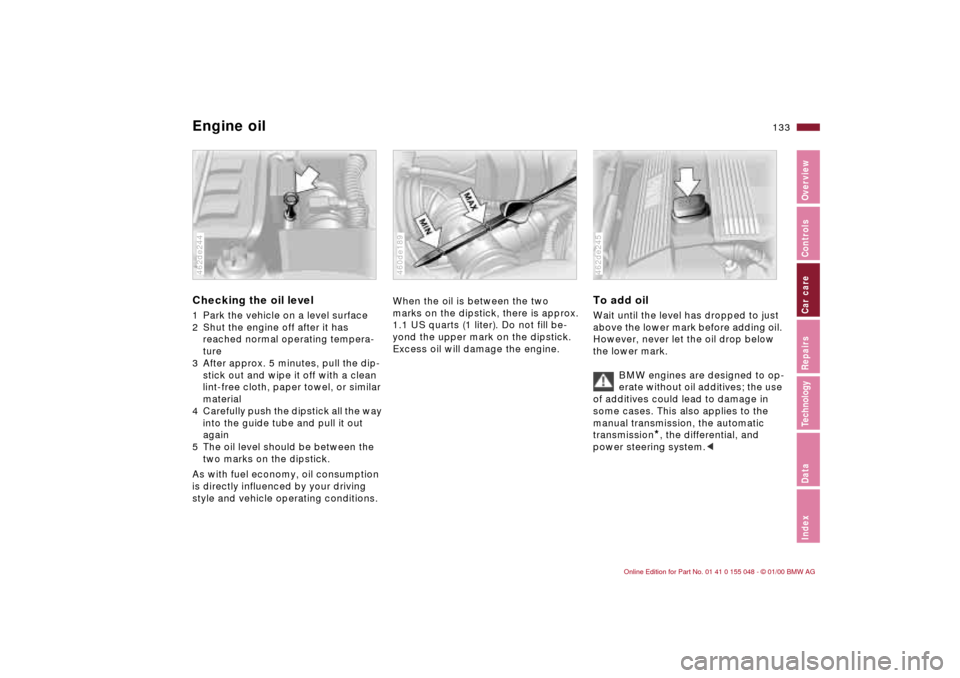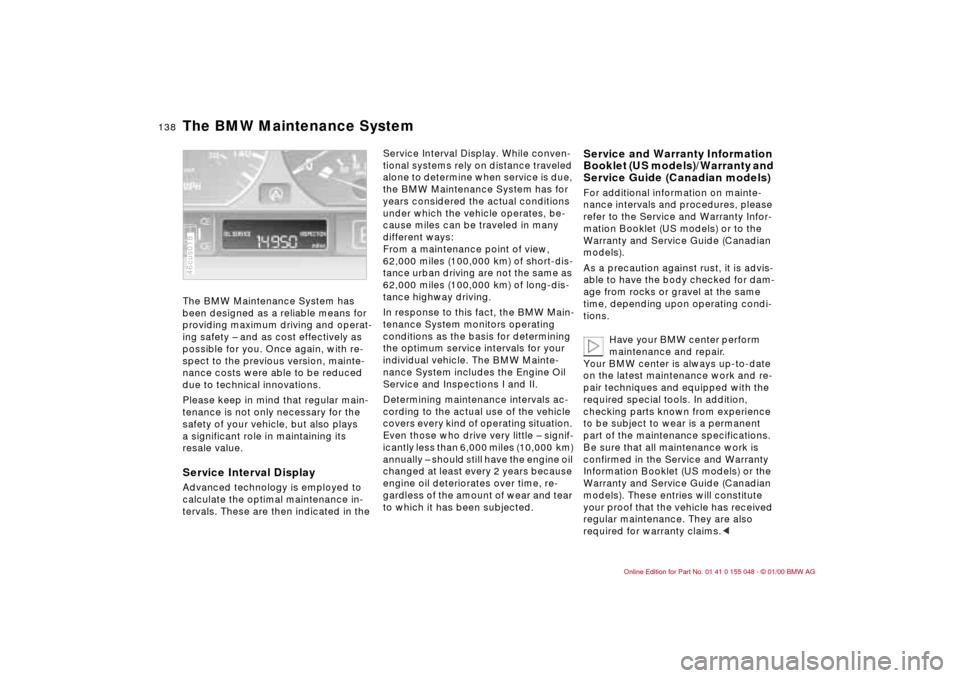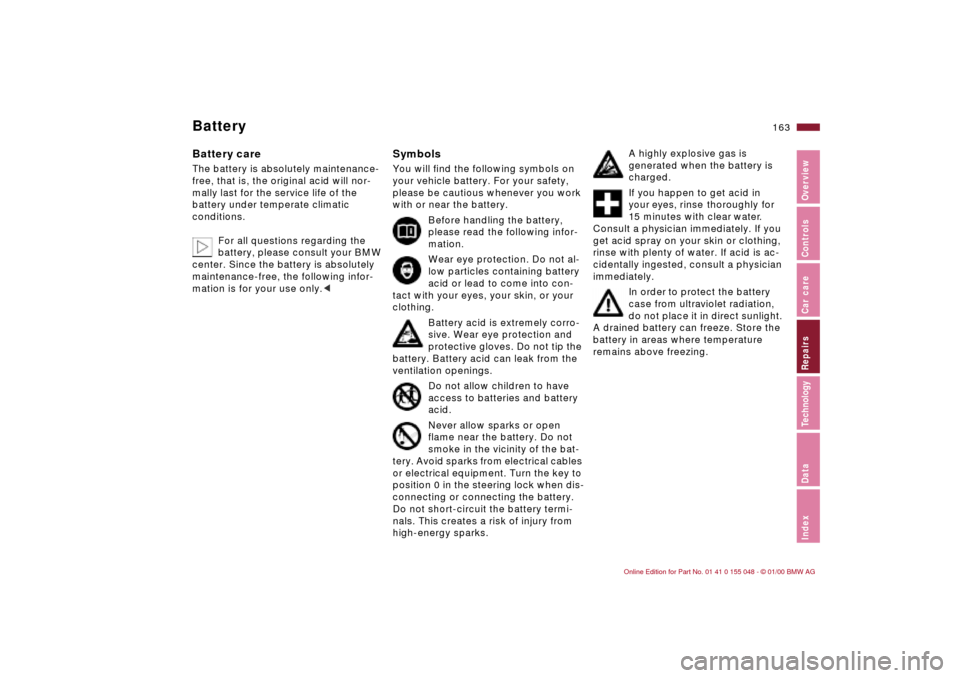2000 BMW 323Ci CONVERTIBLE Air condition
[x] Cancel search: Air conditionPage 127 of 199

127n
IndexDataTechnologyRepairsCar careControlsOverview
Do not exceed specified
maximum speeds
Never exceed the maximum speed
for which winter tires are rated.
Unprofessional attempts by laymen to
service tires can lead to damage and
accidents.
Have this work performed by skilled
professionals only. Any BMW center
has the required technical knowledge
and the proper equipment and will be
happy to assist you.<
Tire condition, tire pressureOnce the tire wears to a tread depth
below 0.16 in (4 mm), winter tires dis-
play a perceptible decrease in their
ability to cope with winter driving condi-
tions, and should be replaced in the
interest of safety.
Comply with the specified tire inflation
pressures – and be sure to have the
wheel and tire assemblies balanced
every time you change the tires.
Winter tiresChoosing the right tireBMW recommends winter tires (M+S
radial tires) for driving in adverse winter
road conditions. Although all-season
tires with the M+S identification provide
better winter traction than summer tires
with H, V, W Y and ZR speed ratings,
they generally fail to provide the same
levels of performance as standard
winter tires.
In the interests of safe tracking and
steering response, install winter tires
made by the same manufacturer having
the same tread configuration on all four
wheels.
Mount only winter tires which have
been approved by BMW. Any BMW
center will be glad to provide you with
information on the best winter tires for
your particular driving conditions.
StorageAlways store tires in a cool, dry place.
Store them away from light whenever
possible. Protect the tires against con-
tact with oil, grease and fuel.Snow chains
*
The use of narrow-link BMW snow
chains on summer or winter tires is
approved only in pairs and only on the
rear wheels. Comply with all manufac-
turer's safety precautions when mount-
ing the chains.
Page 133 of 199

133n
IndexDataTechnologyRepairsCar careControlsOverview
Engine oilChecking the oil level 1 Park the vehicle on a level surface
2 Shut the engine off after it has
reached normal operating tempera-
ture
3 After approx. 5 minutes, pull the dip-
stick out and wipe it off with a clean
lint-free cloth, paper towel, or similar
material
4 Carefully push the dipstick all the way
into the guide tube and pull it out
again
5 The oil level should be between the
two marks on the dipstick.
As with fuel economy, oil consumption
is directly influenced by your driving
style and vehicle operating conditions.462de244
When the oil is between the two
marks on the dipstick, there is approx.
1.1 US quarts (1 liter). Do not fill be-
yond the upper mark on the dipstick.
Excess oil will damage the engine.460de189
To add oil Wait until the level has dropped to just
above the lower mark before adding oil.
However, never let the oil drop below
the lower mark.
BMW engines are designed to op-
erate without oil additives; the use
of additives could lead to damage in
some cases. This also applies to the
manual transmission, the automatic
transmission
*, the differential, and
power steering system.<
462de245
Page 138 of 199

138n
The BMW Maintenance System has
been designed as a reliable means for
providing maximum driving and operat-
ing safety – and as cost effectively as
possible for you. Once again, with re-
spect to the previous version, mainte-
nance costs were able to be reduced
due to technical innovations.
Please keep in mind that regular main-
tenance is not only necessary for the
safety of your vehicle, but also plays
a significant role in maintaining its
resale value.
Service Interval DisplayAdvanced technology is employed to
calculate the optimal maintenance in-
tervals. These are then indicated in the 46cus018
Service Interval Display. While conven-
tional systems rely on distance traveled
alone to determine when service is due,
the BMW Maintenance System has for
years considered the actual conditions
under which the vehicle operates, be-
cause miles can be traveled in many
different ways:
From a maintenance point of view,
62,000 miles (100,000 km) of short-dis-
tance urban driving are not the same as
62,000 miles (100,000 km) of long-dis-
tance highway driving.
In response to this fact, the BMW Main-
tenance System monitors operating
conditions as the basis for determining
the optimum service intervals for your
individual vehicle. The BMW Mainte-
nance System includes the Engine Oil
Service and Inspections I and II.
Determining maintenance intervals ac-
cording to the actual use of the vehicle
covers every kind of operating situation.
Even those who drive very little – signif-
icantly less than 6,000 miles (10,000 km)
annually – should still have the engine oil
changed at least every 2 years because
engine oil deteriorates over time, re-
gardless of the amount of wear and tear
to which it has been subjected.
Service and Warranty Information
Booklet (US models)/Warranty and
Service Guide (Canadian models)For additional information on mainte-
nance intervals and procedures, please
refer to the Service and Warranty Infor-
mation Booklet (US models) or to the
Warranty and Service Guide (Canadian
models).
As a precaution against rust, it is advis-
able to have the body checked for dam-
age from rocks or gravel at the same
time, depending upon operating condi-
tions.
Have your BMW center perform
maintenance and repair.
Your BMW center is always up-to-date
on the latest maintenance work and re-
pair techniques and equipped with the
required special tools. In addition,
checking parts known from experience
to be subject to wear is a permanent
part of the maintenance specifications.
Be sure that all maintenance work is
confirmed in the Service and Warranty
Information Booklet (US models) or the
Warranty and Service Guide (Canadian
models). These entries will constitute
your proof that the vehicle has received
regular maintenance. They are also
required for warranty claims.<
The BMW Maintenance System
Page 163 of 199

163n
IndexDataTechnologyRepairsCar careControlsOverview
BatteryBattery careThe battery is absolutely maintenance-
free, that is, the original acid will nor-
mally last for the service life of the
battery under temperate climatic
conditions.
For all questions regarding the
battery, please consult your BMW
center. Since the battery is absolutely
maintenance-free, the following infor-
mation is for your use only.<
SymbolsYou will find the following symbols on
your vehicle battery. For your safety,
please be cautious whenever you work
with or near the battery.
Before handling the battery,
please read the following infor-
mation.
Wear eye protection. Do not al-
low particles containing battery
acid or lead to come into con-
tact with your eyes, your skin, or your
clothing.
Battery acid is extremely corro-
sive. Wear eye protection and
protective gloves. Do not tip the
battery. Battery acid can leak from the
ventilation openings.
Do not allow children to have
access to batteries and battery
acid.
Never allow sparks or open
flame near the battery. Do not
smoke in the vicinity of the bat-
tery. Avoid sparks from electrical cables
or electrical equipment. Turn the key to
position 0 in the steering lock when dis-
connecting or connecting the battery.
Do not short-circuit the battery termi-
nals. This creates a risk of injury from
high-energy sparks.
A highly explosive gas is
generated when the battery is
charged.
If you happen to get acid in
your eyes, rinse thoroughly for
15 minutes with clear water.
Consult a physician immediately. If you
get acid spray on your skin or clothing,
rinse with plenty of water. If acid is ac-
cidentally ingested, consult a physician
immediately.
In order to protect the battery
case from ultraviolet radiation,
do not place it in direct sunlight.
A drained battery can freeze. Store the
battery in areas where temperature
remains above freezing.
Page 173 of 199

173n
IndexDataTechnologyRepairsCar careControlsOverview
Deceleration sensors continuously
monitor the acceleration forces acting
upon the vehicle. If, as the result of a
frontal collision, a deceleration is
reached at which the protection of the
safety belts alone is no longer ade-
quate, the gas generators of the driver
and passenger-front airbags are ignited.
However, the passenger-side airbag is
only triggered if an additional sensor
has recognized that the passenger seat
is occupied.
In the event of a side collision, the
side airbags in the front are triggered
if necessary. 390de012
The airbags located under the marked
covers inflate and unfold in a matter of
a few milliseconds. In this process, they
tear through the designed separation
points of the upholstered covers or
press them out.
Because the inflation process must be
virtually instantaneous, it is necessarily
accompanied by a certain amount of
ignition and inflation noise. The gas
required to inflate the airbags is not
dangerous, and the smoke associated
with it dissipates.
The entire process is completed within
fractions of a second.Highly sensitive sensors monitor the
wheel speeds, steering angle, lateral
acceleration, brake pressure and the
movement of the vehicle around its
vertical axis.
If differences in the wheel speeds occur,
the system counteracts the danger of
wheelspin by reducing torque. If neces-
sary, the system also responds with
additional brake applications at the
rear wheels.
In addition, DSC permanently monitors
the vehicle's current operating condition
and compares it with an ideal condition
that is calculated from the sensor sig-
nals. If deviations from this occur (un-
dersteering or oversteering, for in-
stance), DSC can stabilize the vehicle in
fractions of a second by reducing engine
output and with the assistance of brak-
ing intervention at individual wheels.
As a result, most skids can be preven-
ted from their very onset.
You may need some time to become
accustomed to this system intervention.
However, it provides optimum drive
force and vehicle stability.
The braking intervention may be
accompanied by sounds specific to
the system.
Airbags DSC
Page 175 of 199

175n
IndexDataTechnologyRepairsCar careControlsOverview
Interior rearview mirror with automatic dimmer
*
The interior rearview mirror with auto-
matic dimming feature reduces glare by
adapting the intensity of the reflected
images to correspond to levels of light
registered by the unit's sensors. The
mirror reverts to its undimmed setting
as soon as the light source disappears.
One light sensor is mounted on the front
of the mirror housing. This sensor, the
one that is directed forward, measures
light intensity in the area ahead of the
vehicle. The second sensor is inte-
grated within the mirror's glass. The
electronic control system compares the
light intensity from front and rear. The
difference provides the basic parameter
used to modulate an electrical current
and induce chemical changes in a semi-
solid layer incorporated in the lens.46cus036
The semisolid reacts chemically to this
electrical current, dimming the mirror
through an infinitely-variable range
(electrochromic technology).
As a result, it is no longer necessary to
dim the mirror manually, and the driver
can concentrate completely on traffic
conditions.
Page 179 of 199

179n
IndexDataTechnologyRepairsCar careControlsOverview
Rollover protection syste
m
Xenon lamps
*
The rollover protection system offers
additional protection apart from the air-
bags and safety belts. The system has
highly sensitive sensors that react im-
mediately upon detecting an unstable
vehicle condition, i.e. when the vehicle
is tilted to a critical degree, or if the
wheels are not making proper ground
contact. In this kind of situation, the
protective bar in each rear head
restraint is triggered.
Xenon lamps illuminate the side and
front areas of the vehicle with signifi-
cantly more brightness and uniformity
than the traditional halogen lamp.
In a xenon lamp, an electric arc re-
places the filament in order to generate
intense illumination. A gas mixture in a
quartz glass tube with metal vapor is
ignited by a high electric voltage. The
arc that is generated is then sustained
by a lower voltage. When the lamp is
turned on there is a brief warm-up
period. Maximum brightness is attained
in approx. 15 seconds.
390de134
Xenon lamps provide significantly im-
proved visibility, especially during ad-
verse weather and poor driving condi-
tions e.g. driving at night in heavy rain
or through road repair areas where
there are no lane markers.
Vehicles with xenon lamps are equipped
with automatic headlamp range control.
As a result, the highway is always opti-
mally lighted, regardless of road condi-
tions, and drivers in oncoming traffic are
not blinded.
Xenon lamps make a significant contri-
bution to highway safety since pedestri-
ans and other highway users, bicyclists
and motorcyclists in the right lane, are
more easily detected.